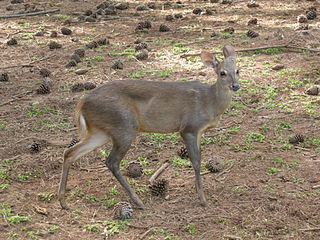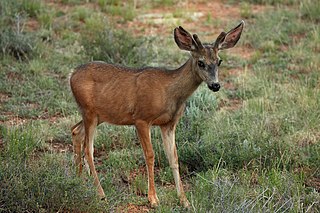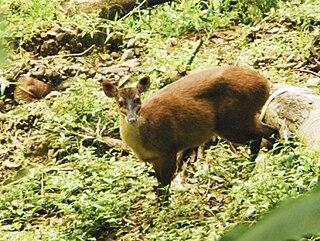
The pygmy brocket is a brocket deer species from South America. It is found in southern Brazil, Argentina and Paraguay. It is a small deer with short legs, weighing 15 to 20 kilograms. It is reddish-brown in color.

Brockets or brocket deer are the species of deer in the genus Mazama. They are medium to small in size, and are found in the Yucatán Peninsula, Central and South America, and the island of Trinidad. Most species are primarily found in forests. They are superficially similar to the African duikers and the Asian muntjacs, but only distantly related. About 10 species of brocket deer are described.

The gray brocket, also known as the brown brocket, is a species of brocket deer from northern Argentina, Bolivia, southern Peru, eastern and southern Brazil, Paraguay, and Uruguay. It formerly included the Amazonian brown brocket and sometimes also the Yucatan brown brocket as subspecies. Unlike other species of brocket deer in its range, the gray brocket has a gray-brown fur without reddish tones.

The common tapeti, also known as the Brazilian cottontail, forest cottontail, or (formerly) simply tapeti is a species of cottontail rabbit. It is small to medium-sized with a small, dark tail, short hind feet, and short ears. As traditionally defined, its range extends from southern Mexico to northern Argentina, but this includes several distinctive population that have since been split into separate species. Under this narrower definition, the true common tapeti only occurs in the Atlantic Rainforest of coastal northeastern Brazil and it is classified as "Endangered" by the IUCN. The American Society of Mammalogists concurs, but also tentatively classifies several distinct populations that have not yet received proper species names into S. brasiliensis, and thus considers it to range from Venezuela south to Argentina.

The Central American agouti is a species of agouti from the family Dasyproctidae. The main portion of its range is from Chiapas and the Yucatan Peninsula, through Central America, to northwestern Ecuador, Colombia and far western Venezuela. A highly disjunct population is found in southeastern Peru, far southwestern Brazil, Bolivia, western Paraguay and far northwestern Argentina. The disjunct population has been treated as a separate species, the brown agouti, but a major review of the geographic variation is necessary. The Central American agouti has also been introduced to Cuba and the Cayman Islands.

The dwarf brocket, or chunyi, is a small species of deer native to the Andean highlands in western Bolivia and southeastern Peru, where it is found in forest and páramo. Its pelage is reddish-brown with dark grey foreparts and neck. The underparts are lighter brown, and the muzzle short and thick. It weighs around 11 kg.

The little red brocket or swamp brocket, also known as the Ecuador red brocket, is a small, little-studied deer native to the Andes of Colombia, Ecuador and northern Peru, where found in forest and páramo at altitudes between 1,400 and 3,600 metres. It is one of the smallest brocket deer. The coat is reddish, and the legs and crown are blackish. As recently as 1999, some authorities included both the pygmy brocket and Merida brocket as subspecies of the little red brocket.

The Yucatan brown brocket is a small species of deer native to Central America.

The robust tuco-tuco is a species of rodent in the family Ctenomyidae. It is a burrowing rodent and is endemic to the Tucumán Province of Argentina.

The small red brocket is a small species of deer in the family Cervidae. It is endemic to Atlantic Forest in Paraná, Santa Catarina and São Paulo in southeastern Brazil. This species, which only was scientifically described in 1996, is threatened by habitat loss. Though its size and structure most resemble that of the pygmy brocket, its coloration is very similar to that of the red brocket. It resembles hybrids between these two species even more closely, but differs from both, and their hybrids, in karyotype.

The Mérida brocket, also known as the Meroia brocket or rufous brocket, is a small species of deer. It is found in forest and páramo at altitudes of 1,000–3,500 metres (3,300–11,500 ft) in the Andes of northern Colombia and western Venezuela. It was once treated as a subspecies of the similar little red brocket, but has been considered a distinct species since 1987, though as recent as 1999 some maintained it as a subspecies.

The Capreolinae, Odocoileinae, or the New World deer are a subfamily of deer. Alternatively, they are known as the telemetacarpal deer, due to their bone structure being different from the plesiometacarpal deer subfamily Cervinae. The telemetacarpal deer maintain their distal lateral metacarpals, while the plesiometacarpal deer maintain only their proximal lateral metacarpals. The Capreolinae are believed to have originated in the Middle Miocene, between 7.7 and 11.5 million years ago, in Central Asia.

The Central American red brocket is a species of brocket deer ranging from southern Mexico, through Central America, to northwestern Colombia.

The lesser capybara is a large semiaquatic rodent of the family Caviidae found in eastern Panama, northwestern Colombia, and western Venezuela. The lesser capybara was described as a species in 1912, but was later re-categorized as a subspecies of the capybara. Following studies of anatomy and genetics in the mid-1980s, it was recommended that it again should be recognized as a separate species, and this gained more widespread recognition in 1991, although some continue to consider it a subspecies.

The cerrado climbing mouse or long-tailed rhipidomys is an arboreal rodent species in the family Cricetidae from South America. It is found in primary or secondary forests of the cerrado and caatinga in central and eastern Brazil, and has also been seen in the Atlantic Forest. Its karyotype is 2n = 44, FN = 48-52. They are nocturnal animals and can be found in both tree canopies and on the ground.
Cerradomys scotti, also known as Lindbergh's oryzomys, is a rodent species from South America in the genus Cerradomys. It is terrestrial and is found in the cerrado (savanna) ecozone of south central Brazil, Bolivia and Paraguay. The species is common and appears to tolerate a degree of agricultural habitat modification.

The Amazonian brown brocket, also known as the small brown brocket, is a small species of deer that is almost entirely restricted to South America.





















